Winter and summer dormancy strengthen adaptive strategies for temperate herbaceous perennials (Review article)
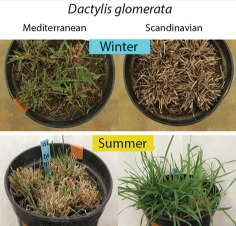
Annals of Botany 119: pp. 311–323, 2017 doi: 10.1093/aob/mcw264
Summer and winter dormancy cycles for temperate herbaceous perennial species are sustained by environmental triggers initiating physiological processes of induction and release. This review article highlights research priorities such as the identification of seasonal factor thresholds and the analysis of biochemical compounds implicated in the dormancy modes of induction and release. Gilliespie and Volaire provide an overview of the growth-stress survival trade-offs inherent in summer and winter dormancy which reinforces the existing body of research on plant adaptations to extreme conditions under climate change.
Authors: L.M. Gillespie and F.A. Volaire
Microsporogenesis and the protective effects of Rye B chromosomes on pollen development
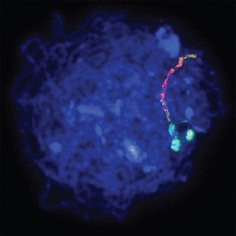
Annals of Botany 119: pp. 325–337, 2017 doi: 10.1093/aob/mcw206
Rye supernumerary (B) chromosomes possess an accumulation mechanism involving the subtelomeric domain enriched by B chromosome specific DNA sequence families, D1100 and E3900. Pereira et al. show that presence of rye B chromosomes may protect pollen mother cells at meiosis against heat stress induced damage. Heat resulted in equal up-regulation of heat shock protein Hsp101 transcripts in plants with zero or 2B chromosomes. A significant up-regulation of E3900 related transcripts occurred in 2B plants at meiotic prophase I, compared to in 0B plants that showed significantly greater heat induced nuclear anomalies. Bioinformatics revealed a high density of known heat responsive cis-regulatory elements within the E3900 sequence and a truncated variant, supporting stress induced response of transcription and a role for B chromosomes in the protection against heat stress induce damage.
Authors: H.S. Pereira, M. Delgado, W. Viegas, J.M. Rato, A. Barão and A.D. Caperta
Museomics reveal phylogeny of endangered Malagasy grasses

Annals of Botany 119: pp. 339–351, 2017 doi: 10.1093/aob/mcw208
Poaceae is one of the most diverse families in Madagascar, but some lineages have not yet been assessed within a phylogenetic framework. This study focused on the threatened taxa of Chasechloa, historically associated with the South American forest grasses of the genus Echinolaena. Silva et al. investigate the evolutionary relationships and origin of Chasechloa using molecular data produced by next-generation sequencing from museum specimens. Chasechloa was found to be only distantly related to Echinolaena. Miocene diversification of Chasechloa is temporally congruent with the origin of other angiosperms in dry forests of North Western Madagascar. Ants may have played a role in shaping the biology of Malagasy grasses as suggested by the presence of oil in the appendages of fertile florets.
Authors: C. Silva, G. Besnard, A. Piot, J. Razanatsoa, R.P. Oliveira and M.S. Vorontsova
Saxophone stem ontogenesis and functions in Acrocomia aculeata (Arecaceae)
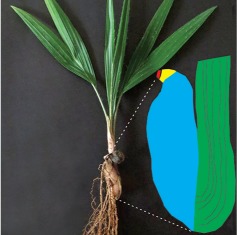
Annals of Botany 119: pp. 353–365, 2017 doi: 10.1093/aob/mcw215
The underground system known as the saxophone stem produced by seedlings of certain palm species exhibits unique growth patterns and distinctive morphologies. Nascimento e Souza et al. performed morpho-anatomical evaluations of seedlings during the development of the saxophone stem in Acrocomia aculeata, a neotropical oleaginous palm. The saxophone stem structure represents an important adaptation to dry environments by promoting the burial of both the shoot apex and storage reserves, which facilitates the continuous growth of aerial organs.
Authors: J. Nascimento e Souza, L.M. Ribeiro, M.O. Mercadante-Simões
Bilateral flower symmetry developmental genetics in Proteaceae

Annals of Botany 119: pp. 367–378, 2017 doi: 10.1093/aob/mcw219
Bilateral symmetry has evolved as an adaptive trait linked to efficient pollination and successful outcrossing, occurring over 170 times in angiosperms and in many plant groups relying upon the asymmetric expression of key transcription factors from the CYC/TB1 gene family. Citerne et al. characterise the evolution of flower symmetry in Proteaceae, a basal eudicot lineage with high diversity in floral morphology, finding that bilateral symmetry is a very labile trait in Proteaceae. The asymmetric expression of CYC/TB1 homologues implicated in the development of bilaterally symmetrical flowers suggests that these genes may have been recruited and harnessed for the control of flower symmetry in this family.
Authors: H.L. Citerne, E. Reyes, M. Le Guilloux, E. Delannoy, F. Simonnet, H. Sauquet, P.H. Weston, S. Nadot and C. Damerval
Ghost orchid symbiotic seed germination

Annals of Botany 119: pp. 379–393, 2017 doi: 10.1093/aob/mcw220
Successful orchid germination, embryo development and seedling establishment require the presence of mycorrhizal fungi. However, little is known about the orchid seed germination niche requirements in situ, especially regarding the role and host specificity of mycorrhizal fungi during germination and subsequent seedling development. Hoang et al. describe the array of effects of the co-culture of mycorrhizal fungal strains, isolated from the roots of the endangered leafless Ghost orchid (Dendrophylax lindenii), on in vitro seed germination, seedling anatomy and developmental morphology. The fungal strain Dlin-394 was confirmed as a possible Ghost orchid germination mycobiont, which significantly promoted seed germination and seedling development. The study highlights the implications of these results for developing efficient procedures for Ghost orchid production and outplanting.
Authors: N.H. Hoang, M.E. Kane, E.N. Radcliffe, L.W. Zettler and L. Richardson
Geraniales flowers revisited: evolutionary trends in floral nectaries
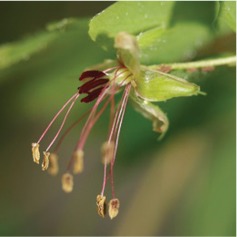
Annals of Botany 119: pp. 395–408, 2017 doi: 10.1093/aob/mcw230
Investigating floral morphology in the order Geraniales, Jeiter et al. present data to demonstrate that even the most disparate floral morphologies are derived from a common origin, sharing a basic pentamerous and pentacyclic organisation with an obdiplostemonous androecium and receptacular nectaries associated with the antesepalous stamens. Floral morphology of the Geraniales shows a high degree of similarity, despite divergence in detail. The variations are predominantly lineage specific, with individual apomorphic characteristics such as zygomorphy or a reduced number of nectaries having arisen several times independently.
Authors: J. Jeiter, M. Weigend and H. Hilger
Holokinetic chromosomes, karyotype evolution and genome size in carnivorous Droseraceae

Annals of Botany 119: pp. 409–416, 2017 doi: 10.1093/aob/mcw229
Previous studies have suggested that carnivory and holokinetic chromosomes might be associated with genome downsizing in plants. Veleba et al. analysed genome evolution in sundews (Droseraceae), a widespread genus that uniquely combines chromosomal holokinetics with carnivory, and their relatives to show that this trend is not universally true. An analysis of genomic parameters and their relationship to climatic niches was undertaken for 71 Droseracae species using flow cytometry and phylogenetic methods to show that the evolution of genomic GC content is inextricably linked with genome size and with environmental conditions such as annual temperature fluctuations. The negative correlation between genome size and chromosome number suggests that karyotype evolution for Australian sundews may be propelled by holokinetic drive.
Authors: A. Veleba, P. Šmarda, F. Zedek, L. Horová, J. Šmerda and P. Bureš
New insights into the evolution of the florally diverse Detarioid legumes
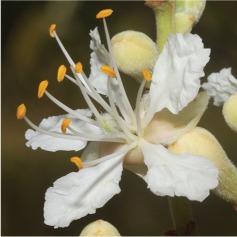
Annals of Botany 119: pp. 417–432, 2017 doi: 10.1093/aob/mcw223
The Brazilian tree Goniorrhachis marginata is the only species of its genus in the bean family (Leguminosae) with striking flowers consisting of a long floral tube and regular corolla redolent of the rose family. Prenner and Cardoso study floral development with a scanning electron microscope and analyse the results in a broad phylogenetic context. Key observations were that the 4-merous calyx has resulted from complete loss of one sepal and that formation of the regular corolla originates from a typical caesalpinioid pattern with the upper petal innermost (ascending aestivation) and the young style bending away from the inflorescence axis. The authors propose a new synapomorphy for the clade further to an extensive dataset analysis showing that abaxial bending styles characterise all major lineages of Detarioid legumes
Authors: G. Prenner and D. Cardoso
Snow depth and summer warming shape arctic leaf anatomy and gas exchange

Annals of Botany 119: pp. 433–445, 2017 doi: 10.1093/aob/mcw237
Climatic changes can result in modified leaf anatomy and gas exchange in arctic plants. In a one-year-old field experiment in Greenland, Schollert et al. investigate the effects of increased snow depth and warming on leaf anatomy, biogenic volatile organic compound (BVOC) emissions and CO2 exchange for the common arctic shrubs Betula nana and Empetrum nigrum ssp. hermaphroditum. Additional snow depth affected the leaf anatomy by increasing the glandular trichome density in B. nana and modifying the mesophyll of E. hermaphroditum. Passive summer warming in open-top chambers thickened the epidermis of B. nana, while increasing the glandular trichome density and reducing the palisade:spongy mesophyll ratio in E. hermaphroditum. The modifications in leaf anatomy suggest a linkage between responses in leaf anatomy, BVOC emissions and CO2 gas exchange, highlighting the ecological importance of monitoring changes in arctic winter precipitation.
Authors: M. Schollert, M. Kivimäenpää, A. Michelsen, D. Blok and R. Rinnan
Revising Corner's rule: how to best partition twig leaf area

Annals of Botany 119: pp. 447–456, 2017 doi: 10.1093/aob/mcw231
Corner's rule states that in woody plants, twigs (current-year shoots) with thicker stems support larger leaves. Larger leaf areas require thicker twigs for hydraulic and mechanical support, but a question remains as to why the pattern of thicker twigs resulting in larger leaves emerges, and also as to whether total leaf area should be partitioned into many small leaves or a few large leaves. Corner's rule implies that larger twig leaf areas should be partitioned into larger sized leaves. Smith et al. verified Corner’s rule in six co-occurring and functionally similar species, finding that individual increases in leaf size correlate in a strikingly consistent manner with increases to twig leaf area. Supporting their hypothesis with computer simulations, the authors propose that the resulting pattern of leaf formation optimises whole twig photosynthesis, thereby offsetting the cost of the endeavour of producing larger leaves.
Authors: D.D. Smith, J.S. Sperry and F.R. Adler
From South America to Shenzhen, China; road trip of an invasive weed Mikania micrantha
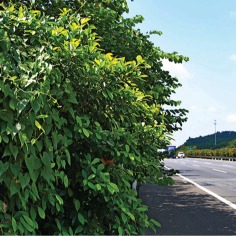
Annals of Botany 119: pp. 457–464, 2017 doi: 10.1093/aob/mcw218
The South American weed Mikania micrantha has spread rapidly across Southern China since its introduction to the Shenzhen region in 1984. Geng et al. used SSR markers to investigate and map genetic diversification of this weed along highways. The results show a relatively low level of genetic differentiation, a lack of clear geographic genetic structure and strong gene flow between populations. The long-distance dispersal of seeds associated with vehicular transportation on highways may have provided corridors for the spread of M. micrantha in Southern China, thereby shaping genetic variation.
Authors: S.-L. Geng, Q. Chen, W.-L. Cai, A.-C. Cao and C.-B. Ou-Yang
Cherry fruit developmental analysis

Annals of Botany 119: pp. 465–475, 2017 doi: 10.1093/aob/mcw232
Evaluating genetic and environmental effects upon sweet cherry cultivars differing in seasonal duration and fruit size, Gibeau et al. employ photographic measurements to apply a framework of biological time indices demarcated by the degrees of growth of reproductive buds, ovarian volume and pits from dormancy to maturation. The initial growth phase is defined by the acceleration of ovary growth in the (minimum) two weeks preceding anthesis, coinciding with bud scale separation. Post-anthesis, unfertilised or otherwise unsuccessful individuals were eliminated statistically with discriminant function analysis prior to polynomial curve fitting and estimation of developmental time. Developmental differences across early, mid and late-maturing cultivars were not detected until the final growth period.
Authors: D.M. Gibeaut, M.D. Whiting and T. Einhorn
Light competition suppresses couch grass more efficiently than nutrient competition

Annals of Botany 119: pp. 477–485, 2017 doi: 10.1093/aob/mcw228
Competitive crops are important for sustainable cropping systems. For perennial weeds, below-ground organs, for instance rhizomes for couch grass, constitute the best measure of a crop’s long term suppressive capabilities. Ringselle et al. found that the type of competition (primarily for light or nutrients) utilised by a crop influences both the suppression rate and the likelihood of whether the crop will successfully alter the weed’s allocation pattern. By competing primarily for light, red clover suppressed the rhizome biomass of couch grass more than perennial ryegrass per gram of produced companion crop biomass. Perennial ryegrass impacted upon couch grass allocation with a higher proportion of rhizomes.
Authors: B. Ringselle, I. Prieto-Ruiz, L. Andersson, H. Aronsson and G. Bergkvist


